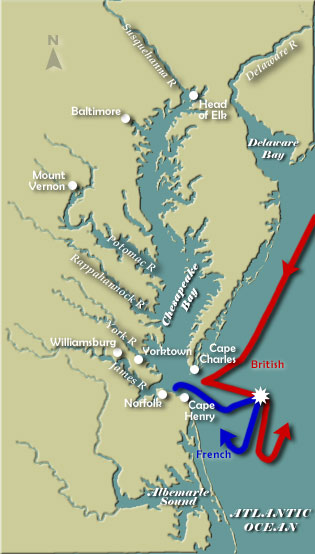In May 1781, Admiral Comte de Barras arrived in Newport, Rhode Island with the long-awaited news that a major French fleet would render assistance to the American cause in the late summer. That fleet, under the command of François Joseph Paul, Comte de Grasse, was en route to the West Indies and would later head to North America. De Barras, lacking sufficient strength to confront the British, sailed off for temporary refuge in Boston Harbor.
In mid-August, Admiral de Grasse sent word to George Washington that the French fleet would sail for service in Chesapeake Bay and be available for joint operations until mid-October. He was unable to make a longer commitment because he had to get his ships to safety at the height of the hurricane season.
 On August 25, a number of British ships under the command of Admiral Sir Samuel Hood arrived in Chesapeake Bay. They searched for French ships and, finding none, sailed off to New York to join Admiral Thomas Graves' larger fleet. Graves took command of the combined force and sailed for the Chesapeake on August 31, arriving in the area on September 5.
Meanwhile, Admiral de Grasse arrived at the mouth of Chesapeake Bay on August 28 with a fleet of 24 ships carrying 1,700 guns and 3,000 soldiers. The land forces were put ashore several days later and joined with the army of the Marquis de Lafayette.
On September 5, Graves was astonished to find the French in possession of Chesapeake Bay. De Grasse realized that conducting naval operations within the bay's confines would be difficult and sailed into the Atlantic waters off the Virginia coast. Most authorities agree that the inept Graves should have struck as the French fleet proceeded in single file into open waters; he did not, which allowed them to form a battle line.
From one perspective, the two-hour Battle of the Capes ended in a draw. The British sustained serious damage to six ships, one of which was later purposely destroyed, and suffered around 300 casualties. The French saw four ships significantly damaged, and sustained more than 200 casualties. Following the encounter and continuing for the next few days, the two fleets drifted south in sight of each other, but did not renew hostilities. From another perspective, despite failing to deliver a knockout blow, De Grasse succeeded in his prime assignment — to seal off the mouth of Chesapeake Bay and deny Cornwallis opportunities for reinforcement or evacuation.
While Graves and de Grasse drifted down the Virginia coast, the smaller French fleet of Admiral de Barras arrived from Newport carrying Rochambeau’s supplies and cannon, and sailed uncontested into Chesapeake Bay. Graves’ critics cite his failure to dispatch seaworthy vessels back to the bay, arguing that the copper-sheathed bottoms of the British ships gave them a decided edge in speed and that they would likely have won a race back to the Chesapeake.
On September 10, Graves broke contact with the French and headed his battered fleet back to New York for repairs, leaving the French in total control of the Chesapeake and probably sealing Cornwallis's fate.
De Grasse then set about the task of transporting Washington's and Rochambeau's forces from the northern Bay area to Williamsburg.
On August 25, a number of British ships under the command of Admiral Sir Samuel Hood arrived in Chesapeake Bay. They searched for French ships and, finding none, sailed off to New York to join Admiral Thomas Graves' larger fleet. Graves took command of the combined force and sailed for the Chesapeake on August 31, arriving in the area on September 5.
Meanwhile, Admiral de Grasse arrived at the mouth of Chesapeake Bay on August 28 with a fleet of 24 ships carrying 1,700 guns and 3,000 soldiers. The land forces were put ashore several days later and joined with the army of the Marquis de Lafayette.
On September 5, Graves was astonished to find the French in possession of Chesapeake Bay. De Grasse realized that conducting naval operations within the bay's confines would be difficult and sailed into the Atlantic waters off the Virginia coast. Most authorities agree that the inept Graves should have struck as the French fleet proceeded in single file into open waters; he did not, which allowed them to form a battle line.
From one perspective, the two-hour Battle of the Capes ended in a draw. The British sustained serious damage to six ships, one of which was later purposely destroyed, and suffered around 300 casualties. The French saw four ships significantly damaged, and sustained more than 200 casualties. Following the encounter and continuing for the next few days, the two fleets drifted south in sight of each other, but did not renew hostilities. From another perspective, despite failing to deliver a knockout blow, De Grasse succeeded in his prime assignment — to seal off the mouth of Chesapeake Bay and deny Cornwallis opportunities for reinforcement or evacuation.
While Graves and de Grasse drifted down the Virginia coast, the smaller French fleet of Admiral de Barras arrived from Newport carrying Rochambeau’s supplies and cannon, and sailed uncontested into Chesapeake Bay. Graves’ critics cite his failure to dispatch seaworthy vessels back to the bay, arguing that the copper-sheathed bottoms of the British ships gave them a decided edge in speed and that they would likely have won a race back to the Chesapeake.
On September 10, Graves broke contact with the French and headed his battered fleet back to New York for repairs, leaving the French in total control of the Chesapeake and probably sealing Cornwallis's fate.
De Grasse then set about the task of transporting Washington's and Rochambeau's forces from the northern Bay area to Williamsburg.